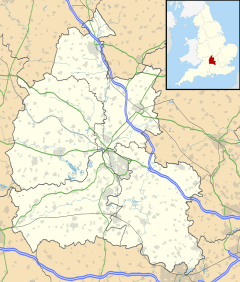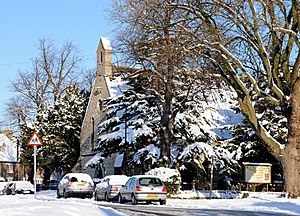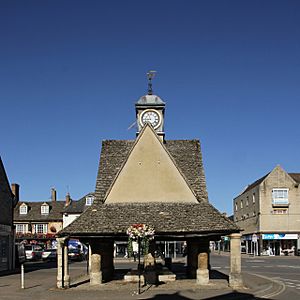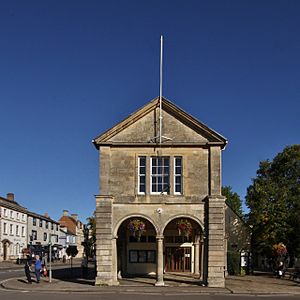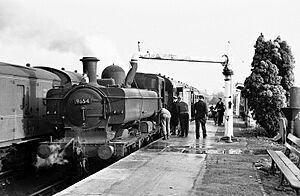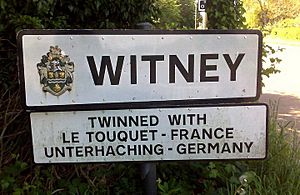Witney facts for kids
Quick facts for kids Witney |
|
|---|---|
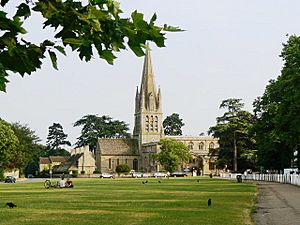 St Mary the Virgin parish church |
|
| Population | 29,632 (2021 Census) |
| OS grid reference | SP3509 |
| Civil parish |
|
| District |
|
| Shire county | |
| Region | |
| Country | England |
| Sovereign state | United Kingdom |
| Post town | Witney |
| Postcode district | OX28 |
| Dialling code | 01993 |
| Police | Thames Valley |
| Fire | Oxfordshire |
| Ambulance | South Central |
| EU Parliament | South East England |
| UK Parliament |
|
| Website | Witney Town Council |
Witney is a busy market town in Oxfordshire, England. It sits by the River Windrush in West Oxfordshire. The town is about 12 miles (19 km) west of Oxford.
Contents
History of Witney
The name "Witney" comes from an old English phrase. It means "Witta's island." The town's name first appeared in a Saxon document in 969. In the Domesday Book of 1086, it was called Witenie. The Domesday Book was a huge survey of England ordered by William the Conqueror.
Churches and Old Buildings
The main church in Witney is St Mary the Virgin. It was first built in the Norman style. This style uses thick walls and round arches. Later, around 1243, the church was mostly rebuilt. It changed to the Early English style, which has tall, narrow windows. Over the years, more parts were added. These included side chapels and new windows. The church tower is 69 feet (21 metres) high. A tall, thin spire makes the total height 154 feet (47 metres). The tower has eight bells that can be rung.
Another church, Holy Trinity Church, was built in 1849. It looks like an older Gothic church. Witney also has a Friends Meeting House. This is where Quakers meet. The Methodist church on High Street was built in 1850. There are also Roman Catholic and Elim Christian churches. Witney High Street has many old buildings. They are protected as part of a special conservation area.
Markets and Town Life
Witney has had a market since the Middle Ages. Market days are Thursday and Saturday. The buttercross in the market square is a famous landmark. People used to come here to buy butter and eggs. It was built around 1600. A clock was added to it in 1683.
The Witney Town Hall was finished in 1786. It has arches on the ground floor. The first floor has a large room for meetings. Witney has always been important for crossing the River Windrush. The bridge in Bridge Street was rebuilt in 1822.
The Workhouse
Witney once had a workhouse on Razor Hill. It was built in 1835–36. A workhouse was a place where poor people could live and work. It had four wings spreading out from a central building. In 1940, the workhouse became an engineering factory. The old chapel became the factory canteen. Later, the main buildings were taken down. Today, only the entrance gate and the old chapel remain. The chapel is now used as offices.
How Witney is Governed
Witney has three levels of local government. These are the town council, the district council, and the county council.
- Witney Town Council handles local matters. Its offices are in the Witney Town Hall.
- West Oxfordshire District Council covers a wider area. Its main offices are also in Witney.
- Oxfordshire County Council manages services for the whole county.
Local Member of Parliament (MP)
Witney is part of the Witney constituency. This means it elects one person to represent it in the UK Parliament. This person is called a Member of Parliament (MP). Since 2024, the MP for Witney has been Charlie Maynard.
Some well-known MPs for Witney include:
- Douglas Hurd: He was a former Foreign Secretary.
- David Cameron: He was the leader of the Conservative Party. He also served as the Prime Minister of the UK from 2010 to 2016.
Changes in Local Government
Witney used to be an "ancient parish." This is an old way of dividing up areas. Over time, the way local areas were governed changed. In 1863, Witney became a "local government district." Later, in 1894, it became an "urban district." This meant it had its own local council.
In 1974, the Witney Urban District was ended. Its jobs were taken over by the new West Oxfordshire District Council. A new local area called Witney was created. Its council is now called Witney Town Council.
Industry in Witney
Witney has been famous for its woollen blankets for hundreds of years. People believed the water from the River Windrush helped make the blankets high quality. The blanket industry was very important to the town. At one point, nearly 3,000 people worked making blankets.
The Blanket Hall was built in 1721. It was used for weighing and measuring blankets. There were once five blanket factories in Witney. However, the largest one, Early's, closed in 2002. This meant the town's blanket industry stopped completely. The old Early's factory has been replaced by new homes.
One of the oldest mill sites in Witney is New Mill. There has been a mill here since the Domesday Book was written. Today, it is the head office for Audley Travel.
Brewing in Witney
For many years, Witney had its own brewery. It was called J.W. Clinch and Co. They started the Eagle Maltings in 1841. In 1961, another company bought Clinch's and closed the brewery.
Later, in 1983, a new brewery called Glenny Brewery started up. It was renamed Wychwood Brewery in 1990. Wychwood made special beers called "real ales." Their most famous beer was Hobgoblin. In 2023, Wychwood Brewery closed down. However, its popular beers are still made in other breweries.
Railways in Witney
The Witney Railway opened in 1861. It connected Witney to Yarnton. Later, another line opened in 1873. This line linked Witney with Lechlade and Fairford. The Great Western Railway ran trains on both lines.
However, in 1962, passenger trains stopped running on the Witney Railway. By 1970, the railway was completely closed down. The tracks were removed.
Idea to Reopen the Railway
Since 2015, a group called Witney Oxford Transport Group (WOT) has suggested reopening the railway. They believe it would help with traffic jams. Witney often has heavy traffic on the roads to Oxford. Reopening the railway could offer a new way for people to travel.
Museums in Witney
Witney has four museums where you can learn about its history:
- Cogges Manor Farm Museum: This museum is in a 13th-century manor house and farm. It shows what farming and country life were like in the past.
- Witney and District Museum: This museum has many old items and documents. They tell the story of Witney town.
- Witney Blanket Hall: Built in the 18th century, this museum shares the history of the Hall and Witney's famous blanket industry. You can even buy Witney blankets here.
- The Wychwood Brewery: This brewery used to make beer. It now has a museum that is open on weekends.
Education in Witney
Witney has several schools for different age groups.
Secondary Schools
There are three main secondary schools in Witney:
- Henry Box School: This school started as Witney Grammar School in 1660. In 1968, it became a comprehensive school. New buildings were added in 1970.
- Wood Green School: This school was founded in 1954. It has been expanded with new teaching rooms and a sports pitch.
- Springfield School: This is a special-needs school. It helps students with severe learning difficulties. The older students' section is located within the grounds of Wood Green School.
There are also two independent secondary schools:
- The King's School: This Christian school was founded in 1984.
- Cokethorpe School: This independent school was founded in 1957.
Primary Schools
Witney has several primary schools:
- St. Mary's School: Established in 1813, it is now a Church of England infant school.
- The Batt School and The Blake School: These are also Church of England primary schools.
- Our Lady of Lourdes Catholic Primary School: This is a Roman Catholic primary school, founded in 1958.
- Community Primary Schools: These include Madley Park, Queen's Dyke, Tower Hill, West Witney, and Witney Community Primary School.
- Springfield School (Primary): This shares a building with Madley Brook Primary.
The former Witney Technical College is now part of Abingdon and Witney College. Its buildings were rebuilt starting in 2008.
Sports in Witney
Witney has many sports clubs for different interests:
- Witney United Football Club: This football team used to be called Witney Town. They were nicknamed the "Blanketmen." They played in the Hellenic League before closing in 2013.
- Witney and District League: This is a local football league with about 32 clubs.
- Witney Rugby Football Club: Their first team plays in the RFU South West 1 East league.
- Wychwood Ladies Hockey Club and Witney Hockey Club: These clubs play field hockey.
- Witney Swifts Cricket Club: Their first team plays in the Oxfordshire Cricket Association Division Three.
- Witney Wolves Basketball Club: This club plays in the Oxford and Chiltern Basketball League.
The Toleman Group Motorsport racing team used to be based in Witney. It later became Benetton Formula and then Renault F1. The team eventually moved to Enstone.
Town Twinning
Town twinning is when two towns in different countries become partners. They often arrange visits and cultural exchanges. Witney is twinned with:
 Unterhaching, Germany
Unterhaching, Germany Le Touquet, France
Le Touquet, France
Floods in Witney
In July 2007, Witney experienced its worst flooding in over 50 years. Many homes and businesses had to be emptied. Bridge Street, a main road that crosses the River Windrush, was closed. About 200 properties in the town centre were flooded. Areas near Bridge Street, Mill Street, and West End were hit the hardest.
Climate in Witney
Witney has a typical British climate. This means it has rainfall spread throughout the year. Temperatures do not change too much between seasons. The nearest weather station is at Brize Norton, about 4 miles (6.4 km) away.
The highest temperature ever recorded was 35.4°C (95.7°F) in August 1990. The lowest temperature was -20.7°C (-5.3°F) in January 1982. On average, Witney gets just under 644 mm of rain each year.
| Climate data for Brize Norton, elevation 88m, 1991–2020, extremes 1901– | |||||||||||||
|---|---|---|---|---|---|---|---|---|---|---|---|---|---|
| Month | Jan | Feb | Mar | Apr | May | Jun | Jul | Aug | Sep | Oct | Nov | Dec | Year |
| Record high °C (°F) | 14.7 (58.5) |
18.4 (65.1) |
25.0 (77.0) |
25.9 (78.6) |
32.2 (90.0) |
33.5 (92.3) |
34.8 (94.6) |
35.4 (95.7) |
33.4 (92.1) |
27.2 (81.0) |
18.3 (64.9) |
16.1 (61.0) |
35.4 (95.7) |
| Mean daily maximum °C (°F) | 7.7 (45.9) |
8.3 (46.9) |
10.9 (51.6) |
13.9 (57.0) |
17.1 (62.8) |
20.1 (68.2) |
22.5 (72.5) |
21.9 (71.4) |
19.0 (66.2) |
14.8 (58.6) |
10.6 (51.1) |
8.0 (46.4) |
14.6 (58.2) |
| Mean daily minimum °C (°F) | 1.7 (35.1) |
1.6 (34.9) |
3.0 (37.4) |
4.8 (40.6) |
7.6 (45.7) |
10.5 (50.9) |
12.6 (54.7) |
12.5 (54.5) |
10.3 (50.5) |
7.5 (45.5) |
4.2 (39.6) |
2.0 (35.6) |
6.5 (43.8) |
| Record low °C (°F) | −20.7 (−5.3) |
−16.1 (3.0) |
−11.1 (12.0) |
−5.2 (22.6) |
−1.7 (28.9) |
−0.3 (31.5) |
4.4 (39.9) |
2.8 (37.0) |
−0.5 (31.1) |
−4 (25) |
−9.6 (14.7) |
−20.5 (−4.9) |
−20.7 (−5.3) |
| Average precipitation mm (inches) | 66.2 (2.61) |
48.1 (1.89) |
46.4 (1.83) |
49.2 (1.94) |
60.1 (2.37) |
49.8 (1.96) |
55.1 (2.17) |
58.6 (2.31) |
54.2 (2.13) |
70.9 (2.79) |
73.2 (2.88) |
74.2 (2.92) |
706 (27.8) |
| Mean monthly sunshine hours | 62.6 | 81.3 | 123.2 | 171.9 | 206.1 | 209.4 | 214.7 | 193.4 | 151.5 | 111.6 | 70.8 | 55.5 | 1,652 |
| Source: Met Office | |||||||||||||
Media and Entertainment
Witney gets its TV signals from the Oxford TV transmitter.
In 2010, WitneyTV started as an online broadcaster. It had a weekly show with local news and events. A small music festival, Witney Music Festival, happens every year. It features local artists and tribute bands. Some famous bands like EMF and The Farm have played there. Witney also has several recording studios.
You can listen to local radio stations like BBC Radio Oxford and Heart South. Witney Radio started in 2012. It broadcasts local news, music, and current affairs. In 2017, it began broadcasting on 99.9 FM. It is on 24 hours a day with local presenters. You can also listen online.
Another online radio station, Windrush Radio, started in 2018. It plays pop and electronic music. It also has shows that feature local artists.
The local newspapers are the Oxford Times, Oxfordshire Guardian, and Witney Gazette.
Notable People from Witney
Many interesting people have connections to Witney, including:
- Emma Appleton, actress
- David Cameron, former MP for Witney and former Prime Minister of the UK
- Jamie Cook, footballer
- Alan Dapre, children's TV show writer
- Lawson D'Ath, footballer
- Jorge Grant, footballer
- Darrell Griffin, rugby league footballer
- Douglas Hurd, former MP for Witney and former Home Secretary
- Charlie Hutchison, British communist
- Martin Jones, concert pianist
- Simon King, footballer
- Graham Leonard, 130th Bishop of London
- Rhys Lewis, singer-songwriter
- Andrew Logan, artist
- Gugu Mbatha-Raw, TV and film actress
- Maddie Moate, television presenter and YouTuber
- David Moss, footballer
- Robbie Mustoe, footballer
- Lorraine Pascal, model and TV chef
- Miss Read (Dora Saint), author
- Larry Sanders, Green party councillor
- William Smith, cricketer
- James Allen Shuffrey, watercolour artist
- Leonard Shuffrey, architect and architectural designer
- Patrick Steptoe, pioneer of fertility treatment
- Dan Tomlinson, Labour politician
- Shaun Woodward, former MP for Witney
See also
 In Spanish: Witney para niños
In Spanish: Witney para niños


